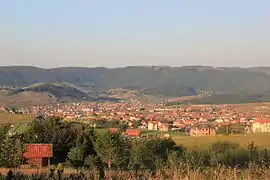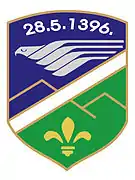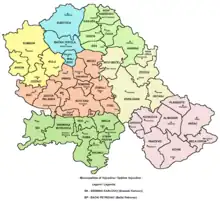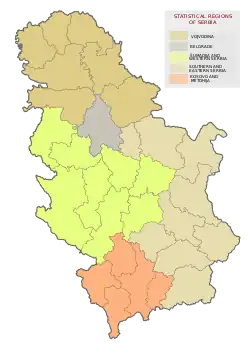Tutin
| |
|---|---|
Town and municipality | |
 _7694.NEF.jpg.webp) _7698.NEF.jpg.webp) _7712.NEF.jpg.webp) _7708.NEF.jpg.webp) Panorama of Tutin | |
 Coat of arms | |
 Location of the municipality of Tutin within Serbia | |
| Coordinates: 42°59′23″N 20°20′11″E / 42.98972°N 20.33639°E | |
| Country | |
| Region | Šumadija and Western Serbia |
| District | Raška |
| Settlements | 93 |
| Government | |
| • Mayor | Bajro Gegic (Tutin na prvom mjestu) |
| Area | |
| • Town | 2.94 km2 (1.14 sq mi) |
| • Municipality | 743 km2 (287 sq mi) |
| Elevation | 867 m (2,844 ft) |
| Population (2022 census)[2] | |
| • Town | 11,169 |
| • Town density | 3,800/km2 (9,800/sq mi) |
| • Municipality | 33,053 |
| • Municipality density | 44/km2 (120/sq mi) |
| Time zone | UTC+1 (CET) |
| • Summer (DST) | UTC+2 (CEST) |
| Postal code | 36320 |
| Area code | +381(0)20 |
| Car plates | TT |
| Website | www |
Tutin (Serbian Cyrillic: Тутин) is a town and municipality located in the Raška District of southwestern Serbia. According to the 2022 census, the municipality has a population of 33,053 people, while the town has a population of 11,169.[3]
History
The settlement of Gluhavica in the territory of Tutin is likely the oldest village attested by name in the municipality. It was an iron mining center of Stefan Milutin, King of Serbia in the early 14th century.[4] After the battle of Kosovo (1389), the Gluhavica mine was the first to be placed under direct Ottoman control in the area. A kadi of Gluhavica is attested as early as 1396.
There is no information about the foundation of the town of Tutin and its etymology is unknown. The village is mentioned for the first time in an 1868 travelogue by British writer M. Mackenzie.[5] In 1700, after the Great Serb Migration, the Albanian Kelmendi and Kuçi and other Albanian tribes like the Shkreli of Rugova established themselves in the region of Rožaje and the neighboring town of Tutin in Serbia. The Shala, Krasniqi, and Gashi also moved into the region.[6][7][8] Starting in the 18th century many people originating from the Hoti tribe have migrated to and live in Sandžak, mainly in the Tutin area, but also in Sjenica.[9] Catholic Albanian groups which settled in Tutin in the early 18th century were converted to Islam in that period. Their descendants make up the large majority of the population of Tutin and the Pešter plateau.[10]
The name of Tutin first appeared in 1868 in the work of English travelers. According to that work, Tutin had only 7 houses of which 6 belonged to the Hamzagić family and one was Serb. Until 1912, Tutin was a small settlement with 20 houses. In the 20th century, the settlement was greatly developed: public buildings, a health station, a school and shops were built. During World War II, Tutin belonged to the Italian protectorate of Albania from 1941 to 1943 and to the Albanian Kingdom from 1943 to 1944, which was a client state of Nazi Germany.
Tutin was the first municipality in Serbia to have renewable wind power. It was opened in 2011 with an installed capacity of 600 KW.[11]
Climate
Tutin has a humid continental climate (Köppen climate classification: Dfb).
| Climate data for Tutin | |||||||||||||
|---|---|---|---|---|---|---|---|---|---|---|---|---|---|
| Month | Jan | Feb | Mar | Apr | May | Jun | Jul | Aug | Sep | Oct | Nov | Dec | Year |
| Mean daily maximum °C (°F) | 1.3 (34.3) |
3.8 (38.8) |
8.8 (47.8) |
13.0 (55.4) |
17.7 (63.9) |
21.2 (70.2) |
23.6 (74.5) |
23.8 (74.8) |
20.3 (68.5) |
14.5 (58.1) |
7.2 (45.0) |
2.7 (36.9) |
13.2 (55.7) |
| Daily mean °C (°F) | −1.9 (28.6) |
0.0 (32.0) |
4.4 (39.9) |
8.2 (46.8) |
12.6 (54.7) |
16.0 (60.8) |
18.0 (64.4) |
18.1 (64.6) |
14.8 (58.6) |
9.8 (49.6) |
3.8 (38.8) |
−0.2 (31.6) |
8.6 (47.5) |
| Mean daily minimum °C (°F) | −5.1 (22.8) |
−3.7 (25.3) |
0.0 (32.0) |
3.4 (38.1) |
7.6 (45.7) |
10.8 (51.4) |
12.5 (54.5) |
12.4 (54.3) |
9.4 (48.9) |
5.2 (41.4) |
0.4 (32.7) |
−3.1 (26.4) |
4.1 (39.5) |
| Average precipitation mm (inches) | 82 (3.2) |
72 (2.8) |
75 (3.0) |
82 (3.2) |
98 (3.9) |
82 (3.2) |
72 (2.8) |
67 (2.6) |
77 (3.0) |
88 (3.5) |
105 (4.1) |
94 (3.7) |
994 (39) |
| Source: Climate-Data.org [12] | |||||||||||||
Demographics
| Year | Pop. | ±% p.a. |
|---|---|---|
| 1948 | 24,662 | — |
| 1953 | 27,963 | +2.54% |
| 1961 | 29,959 | +0.87% |
| 1971 | 29,944 | −0.01% |
| 1981 | 32,779 | +0.91% |
| 1991 | 34,631 | +0.55% |
| 2002 | 30,054 | −1.28% |
| 2011 | 31,155 | +0.40% |
| 2022 | 33,053 | +0.54% |
| Source: [13][3] | ||
According to the 2022 census results, the municipality of Tutin has 33,053 inhabitants.[3] Population that lives in urban areas comprises 32.4% of the municipality's total population. Depopulation is typical for villages because of the migrations to urban and other areas. Population density on the territory of the municipality is 41.99 inhabitants per square kilometer.
Ethnic groups
Most of Tutin's population are Bosniaks (92.01%), followed by Muslims and Serbs. Ethnic composition of the municipality:[3]
| Ethnic group | Population 1991 |
Population 2002 |
Population 2011 |
Census 2022 | |
|---|---|---|---|---|---|
| Population | % | ||||
| Bosniaks | - | 28,320 | 28,041 | 30,413 | 92.01 |
| Serbs | 1,503 | 1,298 | 1,090 | 704 | 2.13 |
| Muslims | 32,671 | 222 | 1,092 | 340 | 1.03 |
| Romani | - | - | 67 | 29 | 0.09 |
| Gorani | - | - | 55 | 52 | 0.16 |
| Others | 457 | 214 | 810 | 1,515 | 4.58 |
| Total | 34,631 | 30,054 | 31,155 | 33,053 | |
Note: Most of those who in 1991 census declared themselves as ethnic Muslims, in the next census in 2002 declared themselves as Bosniaks, while the smaller number of them still declare themselves as ethnic Muslims.
Economy
The following table gives a preview of total number of registered people employed in legal entities per their core activity (as of 2018):[14]
| Activity | Total |
|---|---|
| Agriculture, forestry and fishing | 78 |
| Mining and quarrying | 55 |
| Manufacturing | 898 |
| Electricity, gas, steam and air conditioning supply | 43 |
| Water supply; sewerage, waste management and remediation activities | 52 |
| Construction | 210 |
| Wholesale and retail trade, repair of motor vehicles and motorcycles | 516 |
| Transportation and storage | 121 |
| Accommodation and food services | 135 |
| Information and communication | 27 |
| Financial and insurance activities | 20 |
| Real estate activities | - |
| Professional, scientific and technical activities | 91 |
| Administrative and support service activities | 18 |
| Public administration and defense; compulsory social security | 357 |
| Education | 720 |
| Human health and social work activities | 416 |
| Arts, entertainment and recreation | 38 |
| Other service activities | 189 |
| Individual agricultural workers | 739 |
| Total | 4,722 |
Notable people
- Mensur Suljović (born 1972), Austrian darts player
- Saffet Sancaklı (born 1966), Turkish footballer, politician
International relations
Twin towns – Sister cities
Tutin is twinned with:
See also
References
- ↑ "Municipalities of Serbia, 2006". Statistical Office of Serbia. Retrieved 2010-11-28.
- ↑ "2022 Census of Population, Households and Dwellings: Ethnicity (data by municipalities and cities)" (PDF). Statistical Office of Republic Of Serbia, Belgrade. April 2023. ISBN 978-86-6161-228-2. Retrieved 2023-04-30.
- 1 2 3 4 "2022 Census of Population, Households and Dwellings" (PDF). Retrieved 2023-12-07.
- ↑ Velović Popović 2021, p. 173.
- ↑ Velović Popović, Bojana M. (2021). "Морфолошке одлике глаголских облика говора Тутина, Новог Пазара и Сјенице" [Morphological features of verb forms in speech from Tutin, Novi Pazar and Sjenica] (PDF). Српски дијалектолошки зборник (68): 168.
- ↑ Mušović, Ejup (1985). Tutin i okolina. Serbian Academy of Science and Arts. p. 27.
- ↑ The Tribes of Albania,: History, Culture and Society. Robert Elsie. 24 April 2015. p. 104. ISBN 9780857739322.
- ↑ Kaser, Karl (1992). Hirten, Kämpfer, Stammeshelden: Ursprünge und Gegenwart des balkanischen Patriarchats. Böhlau Verlag Wien. p. 163. ISBN 3205055454.
- ↑ Biber, Ahmet. "HISTORIJAT RODOVA NA PODRUČJU BJELIMIĆA". Fondacija "Lijepa riječ".
- ↑ Velović Popović 2021, pp. 197–199.
- ↑ "Prva srpska vetrenjača u Tutinu". b92.net (in Serbian). Tanjug. 11 April 2011. Retrieved 19 February 2020.
- ↑ "Climate: Tutin, Serbia". Climate-Data.org. Retrieved January 10, 2018.
- ↑ "2011 Census of Population, Households and Dwellings in the Republic of Serbia" (PDF). stat.gov.rs. Statistical Office of the Republic of Serbia. Retrieved 11 January 2017.
- ↑ "MUNICIPALITIES AND REGIONS OF THE REPUBLIC OF SERBIA, 2019" (PDF). stat.gov.rs. Statistical Office of the Republic of Serbia. 25 December 2019. Retrieved 28 December 2019.
- ↑ "Mostar Gradovi prijatelji" [Mostar Twin Towns]. Grad Mostar [Mostar Official City Website] (in Macedonian). Archived from the original on 2013-10-30. Retrieved 2013-12-19.
- ↑ "Kardeş Belediyeler" [Gaziosmanpaşa Twin Towns]. Gaziosmanpaşa [Gaziosmanpaşa Official Website] (in Turkish). Archived from the original on 2017-10-30. Retrieved 2017-12-19.
- ↑ "Kardeş Belediyeler" [Iznik Twin Towns]. Iznik [Iznik Official Website] (in Turkish). Retrieved 2017-12-19.
External links


